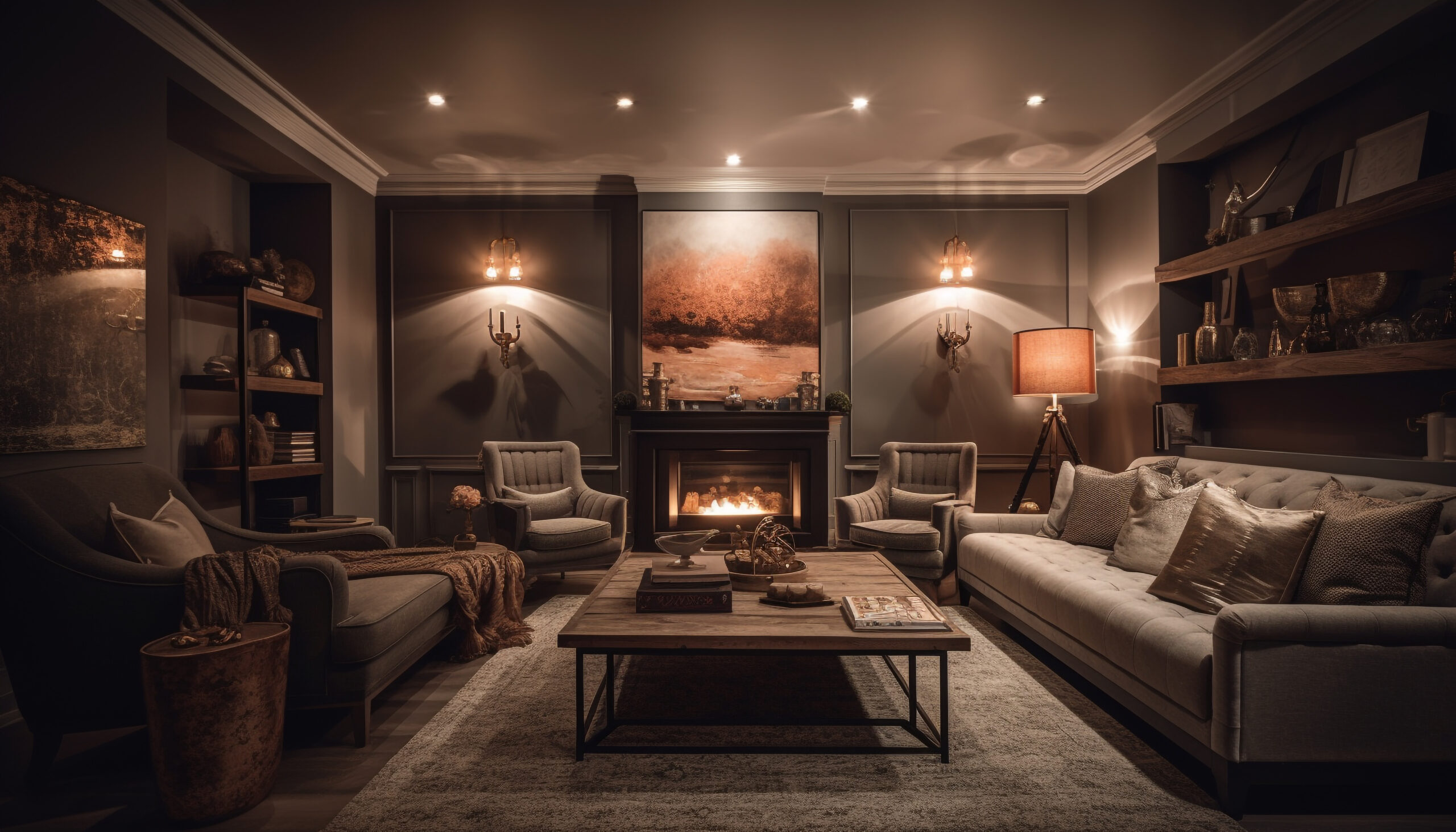In a world changing at an unprecedented pace, interior design is no longer just a matter of taste—it has become a mirror reflecting our lifestyles, values, and even emotional states. The year 2025 doesn’t merely bring new color palettes or shapes; it introduces a deeper philosophy that calls for balance between technology and warmth, boldness and comfort, past and future.
Our homes have transformed into multifunctional spaces: offices, retreats, meditative sanctuaries, and even platforms for self-expression. That’s why this year’s trends lean toward sensory, sustainable, and experiential design—blending visual comfort with smart technologies, nostalgia with modern elegance.
In this article, we’ll guide you through the top interior design trends for 2025—from expressive walls and embracing furniture to color palettes rich in drama and subtle details that whisper warmth.
Warm Neutrals: The Earth-Toned Comeback
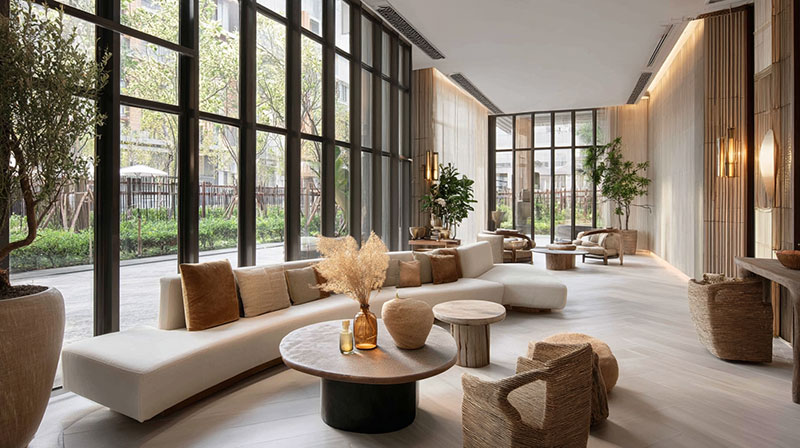
In 2025, neutrality no longer equates to coldness or visual emptiness. On the contrary, the compass of design has shifted toward a warmer, more human-centered neutral palette inspired by the earth and nature. Shades like sand beige, caramel, clay, and sage have become foundational in interior design not just for their versatility, but for the sense of calm and emotional comfort they bring to a space.
This trend is ideal for homes seeking a balance between simplicity and depth, and it suits nearly every style from cozy farmhouse to sleek contemporary. When paired with natural materials like light wood, linen, or stone, these tones transform a room into a sensory retreat that feels welcoming from the very first glance.
Warm neutrals are a quiet translation of psychological comfort. They say so much without speaking expressing a mature aesthetic that knows how to balance distinction with serenity.
Sensory Design: Engaging All Five Senses
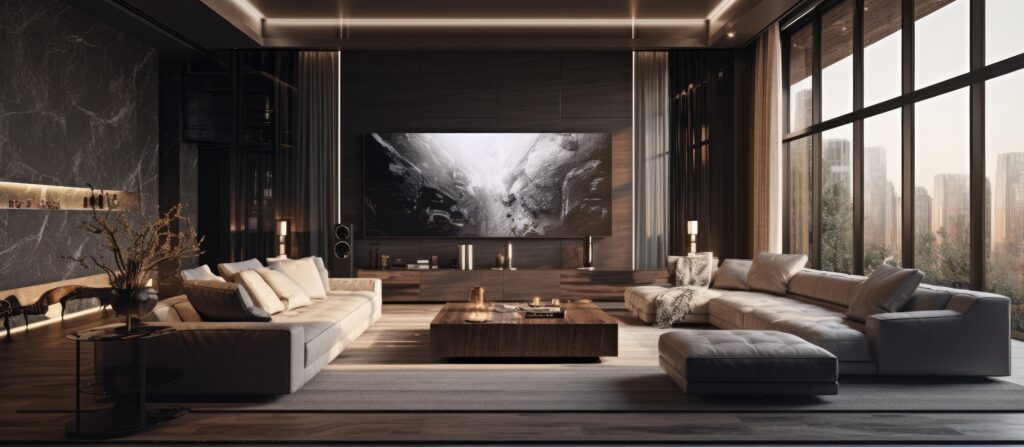
Interior design in 2025 is no longer judged solely by what pleases the eye it’s about what can be touched, heard, and even felt emotionally. The design world is embracing a holistic approach that engages all five senses, creating immersive living environments that connect more deeply with the people who inhabit them.
Touch is expressed through material choices: soft fabrics, raw wood surfaces, and thick, cozy carpeting. Each texture is selected to offer a tactile sense of comfort and warmth. Sound enters the scene through subtle elements like tabletop fountains or integrated sound systems playing soft music or nature sounds that promote mental clarity. Scent also plays a growing role, incorporated through scented candles, diffusers, or natural oils that give each room a distinctive identity.
Even lighting is now designed with sensory depth in mind. It’s layered and adjustable, allowing spaces to shift from bright daylight to calming evening glows, all tailored to mood and time of day.
This trend goes beyond aesthetics it’s about feeling alive in your home. It’s a design you don’t just see, but sense, experience, and live through every part of your being.
Blending Indoor and Outdoor Spaces
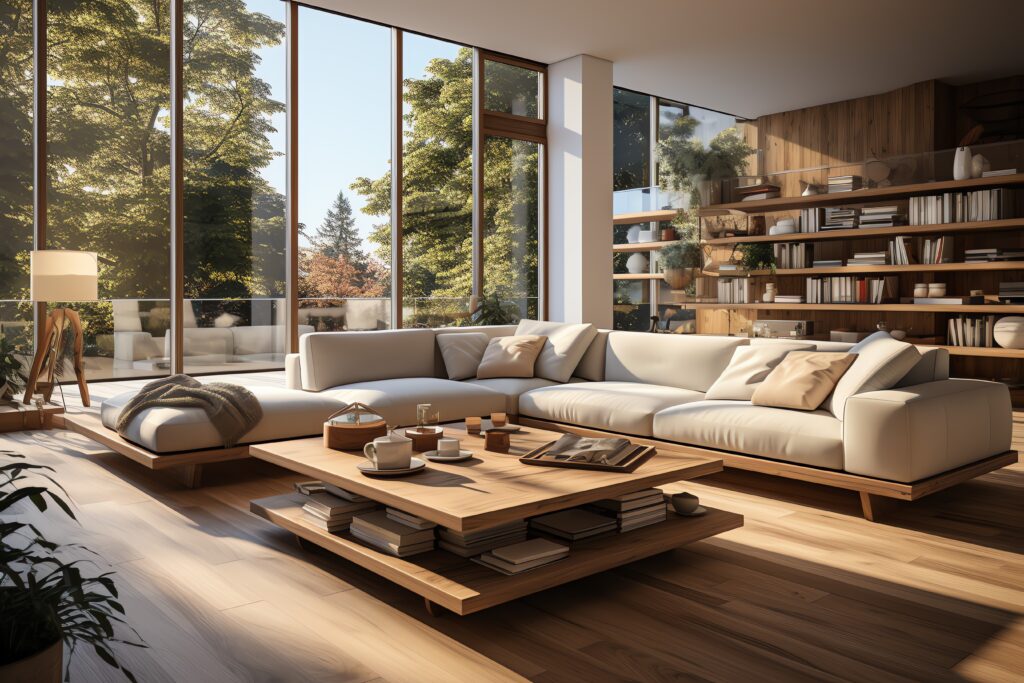
In 2025, the boundary between indoors and outdoors has all but disappeared. It has become increasingly common for interior spaces to breathe in the open air, while gardens and balconies reflect the soul of the indoors. This merging of worlds is not just a visual trend, but a modern lifestyle necessity and architectural language that expresses openness, comfort, and fluidity.
Folding glass doors and floor-to-ceiling windows are now key design elements that physically and visually connect the interior with the exterior. Unifying flooring such as using similar wood or stone indoors and out creates seamless transitions that make the entire home feel like one continuous, harmonious space.
Outdoor areas have also evolved. No longer limited to plastic chairs and collapsible tables, they now serve as luxurious extensions of the living room featuring weather-resistant sofas, cozy rugs, ambient lanterns or pendant lighting, and even outdoor TVs or fireplaces.
This integration enhances everyday living by turning every corner of the home into a usable, meaningful space not just décor. It’s a lifestyle that redefines comfort and keeps us connected to nature, even from within the heart of our homes.
Certainly! Here’s the English translation of that section:
Furniture That Embraces You: Comfort First
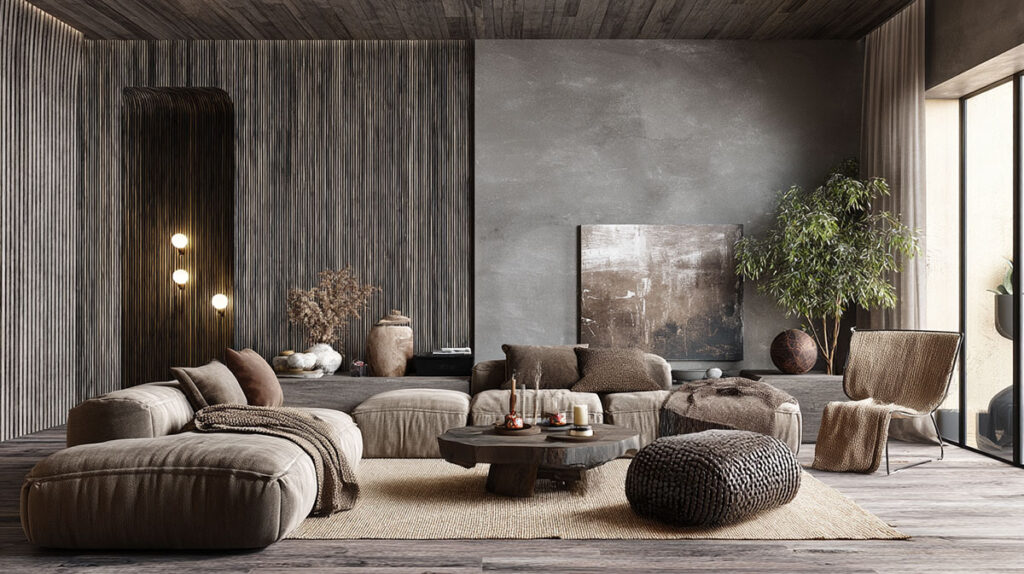
In 2025, furniture is no longer judged solely by its aesthetic or trendy design, but by the comfort it offers to both body and soul. The leading direction now is toward “furniture that embraces you” pieces that feel like warm blankets, crafted to make you feel safe, supported, and connected to your space.
Sofas are becoming wider, softer, and more curvaceous, with plenty of cushions and inviting fabrics like organic cotton, linen, or boucle that practically beg you to lounge for hours. Chairs are no longer just for sitting they encourage curling up, sinking in, and truly relaxing. Even coffee tables have evolved beyond sharp edges and rigid forms; they’re now soft, rounded, and organic in shape, inviting interaction and flowing with the rhythms of daily life.
This trend fits homes that value human connection over showiness spaces where emotional comfort is just as important as visual harmony. It’s furniture that doesn’t require a formal setting it welcomes you in every spontaneous moment you spend at home.
Whether you favor a minimalist approach or an eclectic, vibrant style, comfortable furniture has become the essential starting point for any modern interior that truly puts the user at the heart of the experience.
Saturated and Dramatic Colors: No More Fear of Bold Expression

In 2025, colors boldly take center stage in interior design—not as secondary decorations, but as the main characters redefining a space’s visual mood. After years of relying on neutral tones as the safe choice, saturated hues are breaking the monotony and reviving walls, ceilings, and even core furniture pieces.
Dramatic shades like Deep Burgundy, Olive Green, Misty Blue, and Soft Black are among the trendiest colors this year. Each tells a unique story: Deep Burgundy symbolizes maturity and confidence; Olive Green evokes grounded natural elegance; Misty Blue soothes the eyes and calms the soul; and Soft Black offers depth without harshness.
This trend isn’t confined to walls. Rich colors now flow into sofas, curtains, rugs, and even kitchens and wardrobe cabinetry. Spaces are often built around a dominant saturated hue, harmonized with warm metallics like gold and copper, or paired with natural materials such as wood and stone.
It’s not about visual shock—it’s about unapologetic self-expression. This style reflects personalities that are bold, authentic, and unafraid to show their preferences.
What makes these 2025 colors remarkable is their versatility. They can serve as a calm, poetic backdrop or a vivid focal point, depending on their placement and lighting. These are colors that say: Don’t be afraid to be seen. Don’t be afraid to express yourself.
Lighting as Art: From Chandeliers to Sculpted Spotlights
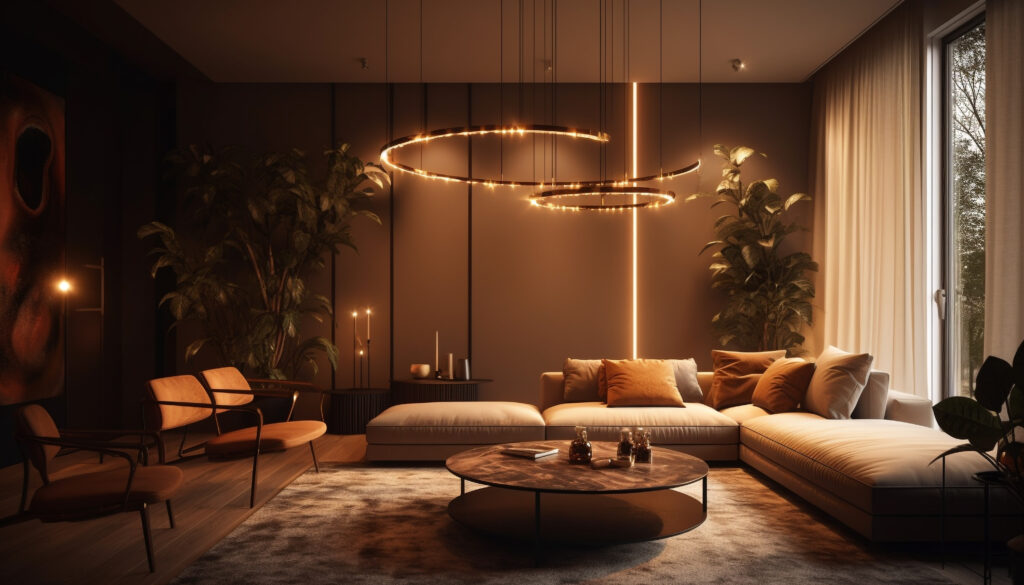
In 2025, lighting is no longer seen as merely functional it has evolved into a central artistic element that adds visual and emotional depth to a space. Designers now treat lighting fixtures as hanging sculptures and mood-setting tools, rather than just sources of illumination.
Lighting has transformed from classic chandeliers to contemporary pieces that resemble art installations crafted from polished glass, curved metals, stretched fabrics, and even organic materials like wood and bamboo. Directed lighting has become a key design feature, spotlighting specific interior elements such as wall art, indoor plants, feature walls, or cozy reading corners.
Beyond aesthetics, the real power of lighting lies in how it shapes a room’s atmosphere. Warm lighting is favored for living rooms and bedrooms to create a sense of comfort and intimacy, while cool white lighting is ideal for kitchens and workspaces. Ambient and hidden lighting provides a soft gradient that casts elegant shadows and enhances spatial depth.
One of the standout trends of 2025 is the rise of customizable smart lighting, which allows users to adjust brightness and color temperature based on time, mood, or activity. We’re also seeing lighting integrated directly into walls, floors, and ceilings so seamlessly that it feels as though light is emerging from the design itself, not simply added to it.
Ultimately, lighting has become its own design language. It doesn’t just illuminate it highlights, defines, and transforms the space into a living, breathing visual experience.
Here’s the English translation of your paragraph:
A Contemporary Revival of Antique and Heritage Pieces
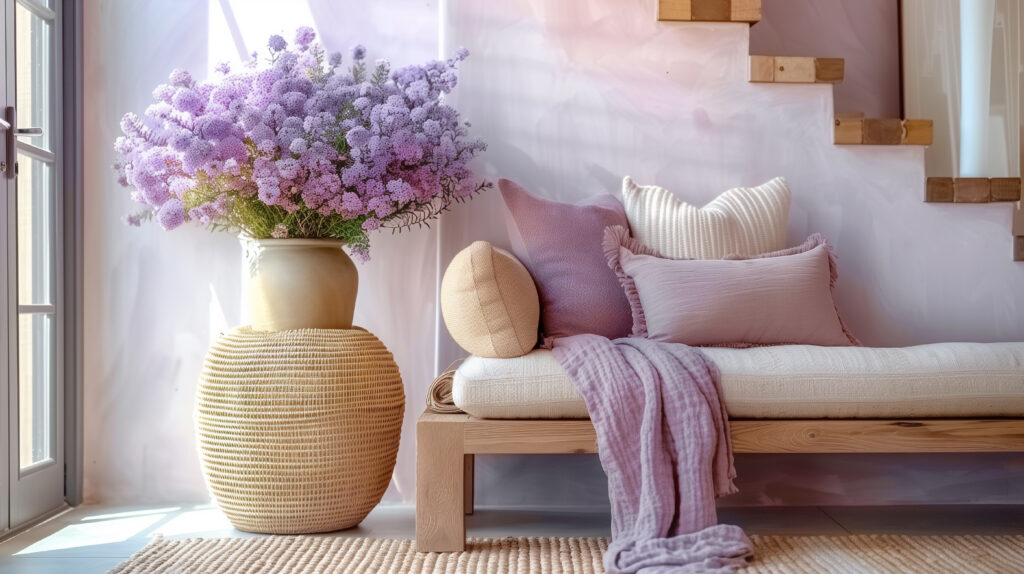
Among the standout interior design trends of 2025 is the elegant return of antique and heritage elements reinterpreted with a modern spirit. Rather than filling spaces solely with brand-new items, design lovers are embracing the charm of vintage pieces, whether family heirlooms, flea market finds, or classic furniture, and weaving them seamlessly into contemporary interiors.
This revival isn’t driven by nostalgia alone it’s fueled by a global passion for the stories that objects carry. A wooden table marked by time, a hand-carved armoire, or a traditionally woven rug all add depth and authenticity to a home, offering a one-of-a-kind presence that cannot be replicated.
Yet the spirit of the age favors balance. In 2025, these pieces are being reframed within minimalist designs and often paired with modern materials like clear glass or warm metals. The result is a visual dialogue between past and present. Think of a vintage chair reupholstered in contemporary fabric, or a rustic table positioned next to a sleek, modern sofa a daring yet intentional mix.
This trend works beautifully with transitional, bohemian, and modern farmhouse styles, offering both designers and homeowners the freedom to express their personality and taste. It also supports sustainability values by giving new life to pieces that might otherwise be discarded transforming them into meaningful focal points.
The result? A home that pulses with authenticity, reflecting not just trends, but character, stories, and timeless beauty.
Warm Metals: The Refined Return of Copper and Gold
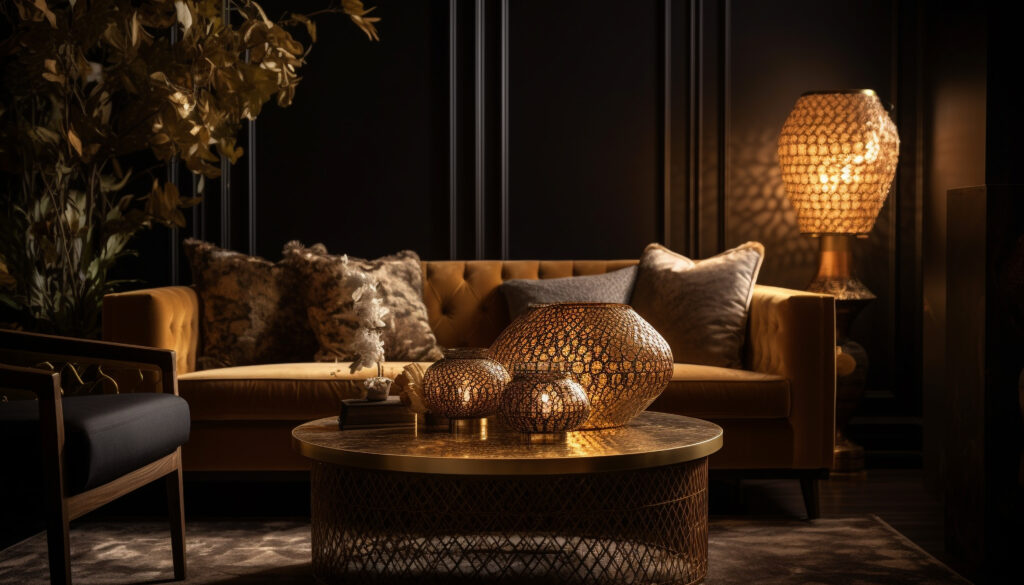
After years of dominance by matte black and cold steel in industrial design, warm metals like copper and gold are making a comeback in the interior design scene—but this time with a more refined and understated tone. Gone is the flashy metallic glam of the early 2000s; 2025 brings a mature, thoughtful revival that highlights soft luster, delicate detailing, and smart integration into the overall design context.
In 2025, brushed or oxidized copper is seen in cabinet handles, mirror frames, lighting fixtures, and even table bases. Meanwhile, antique gold accents appear in decorative touches such as curtain rod finials or metal trims on living room furniture.
This trend suits design styles that balance classical and contemporary elements—such as eclectic interiors, warm contemporary aesthetics, or upscale bohemian styles. It pairs beautifully with earthy color palettes like sand beige or olive green, creating an elegant contrast that feels sophisticated rather than overwhelming.
The key to embracing this trend is moderation. There’s no need to flood a space with metal. Instead, use it as a visual anchor in two or three focal points—like a central pendant light or a framed statement mirror in copper.
Beyond their visual appeal, warm metals bring a sense of richness and comfort to interiors. They also reinforce a sense of artisanal quality and craftsmanship. In short, this is a touch of the past, reimagined through the lens of the future.
The Personal Touch: A Home That Looks Like You
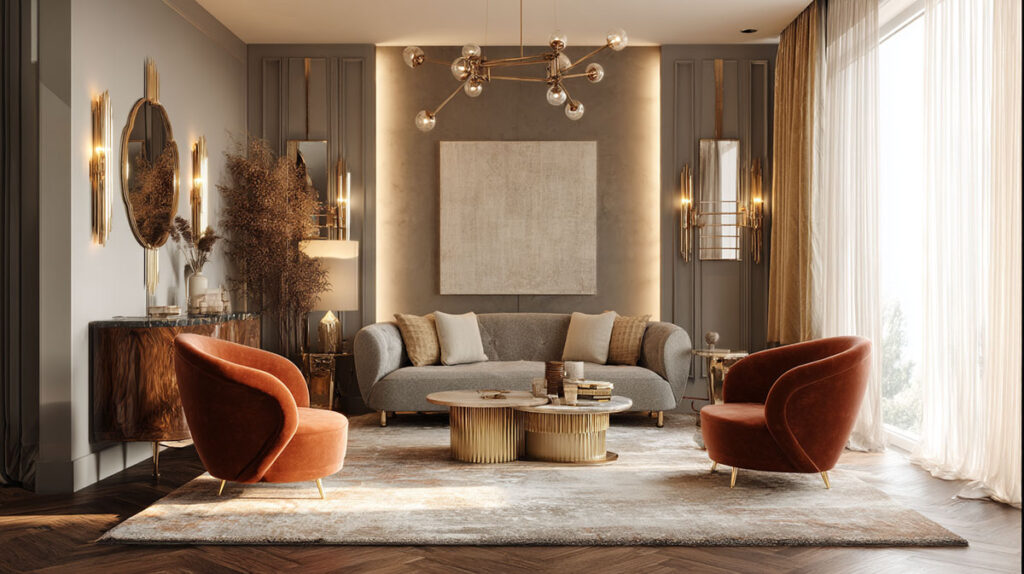
In a world filled with idealized images and lookalike interiors, 2025 introduces a fresh trend that puts the human experience back at the heart of design: “a home that looks like you.” No longer is the goal to copy a room from a magazine or inspiration app it’s about building a space that reflects your personality, taste, and daily rhythm.
This personal touch comes alive in the small details: a handmade piece of art, a bold color that expresses your mood, or a reading nook arranged just to hold your quiet moments. It might be a painting you created on vacation, a hand-embroidered pillow from a past journey, or a sentimental keepsake on a shelf that catches your eye every morning.
This movement celebrates real life over perfection, allowing spaces to embrace authentic beauty and encouraging you to break traditional design rules. It gives you permission to mix what you love regardless of colors, textures, or styles and weave your memories into your space.
Practically speaking, technology is helping make this vision a reality. Tools like Zory let you explore endless combinations and visualize how specific elements can come together to create a space that truly feels like your own.
In 2025, personal design isn’t just a luxury it’s an emotional and aesthetic necessity. Because when your home looks like you, every corner becomes comforting, familiar, and inspiring.
3D Wall and Ceiling Designs: A New Dimension of Visual Expression

In 2025, walls and ceilings are no longer treated as flat surfaces with merely functional roles they have become vibrant canvases, celebrated as standalone works of art. Three-dimensional designs are emerging as one of the most advanced trends, adding depth, motion, and a sensory experience that enriches any space without the need for excessive ornamentation.
The materials used in this type of décor vary from PVC and MDF panels to intricately carved natural wood, forming geometric shapes, organic waves, or patterned repetitions that interact with light in a dynamic way. This trend is ideal for modern spaces, home offices, and living rooms, and can be used in entryways to leave a striking first impression.
Ceilings have not been left out of this visual revolution they are now zones of creative expression themselves. 3D panels with hidden LED lighting are used to highlight patterns, while hanging sculptural elements are integrated in harmony with the room’s lighting and color scheme.
One of the greatest advantages of this trend is its ability to instantly create visual depth without the need for major structural changes. Simply installing the panels transforms a previously unnoticed wall into a stunning focal point. Playing with color gradients and lighting further enhances this effect.
3D wall designs express the personality of a space and break visual monotony, making them a perfect choice for those who appreciate thoughtful boldness and seek a stylish, unconventional way to reflect their unique taste.
Elegant Maximalism: The Art of Balancing Color and Pattern with Bold Sophistication
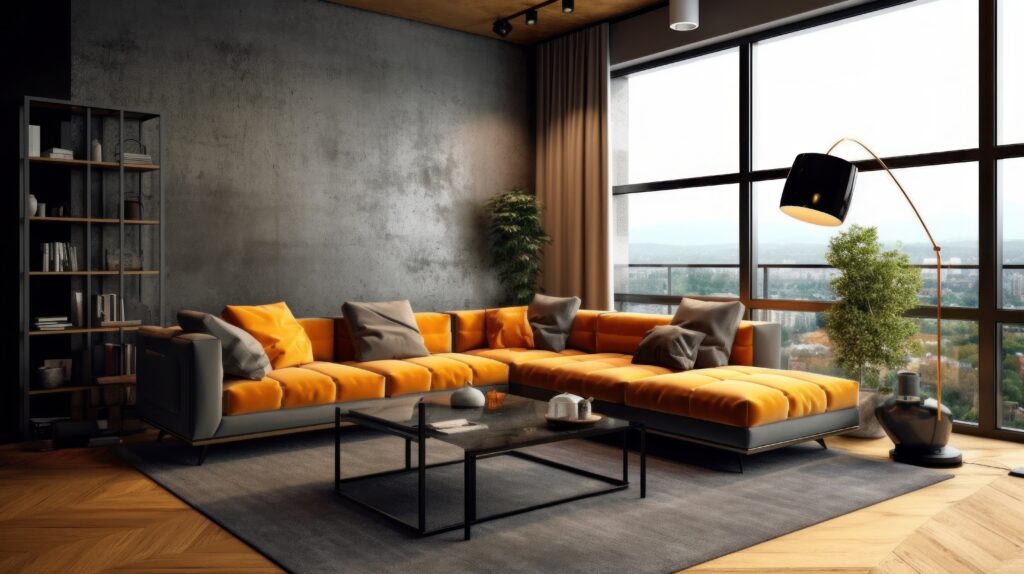
In 2025, crowding a room with visual elements is no longer a design mistake it’s a bold and celebrated trend known as Elegant Maximalism. This design movement rejects silent, empty spaces in favor of layered richness, visual contrast, and curated abundance in color, patterns, and textures.
What sets this modern take on maximalism apart is its refined intentionality. It’s no longer about chaotic décor, but rather about a deliberate orchestration where each object tells a story and every color plays a note in a well-composed visual symphony.
This style comes to life in rooms with bold wallpaper featuring oversized botanical or abstract prints, walls painted in deep jewel tones like emerald green or mustard yellow, and sofas covered in a patchwork of striped, floral, or embroidered cushions. Coffee tables might hold a mix of vintage finds, sculptural accents, and global artifacts all harmonized with artistic flair.
The challenge of maximalism lies in striking the perfect balance between old and new, loud and quiet, spontaneous and structured. Every corner feels full… but never overwhelming. Every detail catches the eye… but never demands it all.
This trend is especially appealing to art lovers, avid travelers, collectors, and those who see their home as an extension of their personality. It thrives in spaces where self-expression meets storytelling with depth, joy, and unapologetic creativity.
Whether you’re creating a gallery wall of eclectic art, pairing a colorful rug with velvet seating, or mixing seemingly clashing prints with confidence Maximalism in 2025 is not chaos it’s a lifestyle defined by vibrant harmony.
Blending Styles: Where Modern Meets Rustic Charm
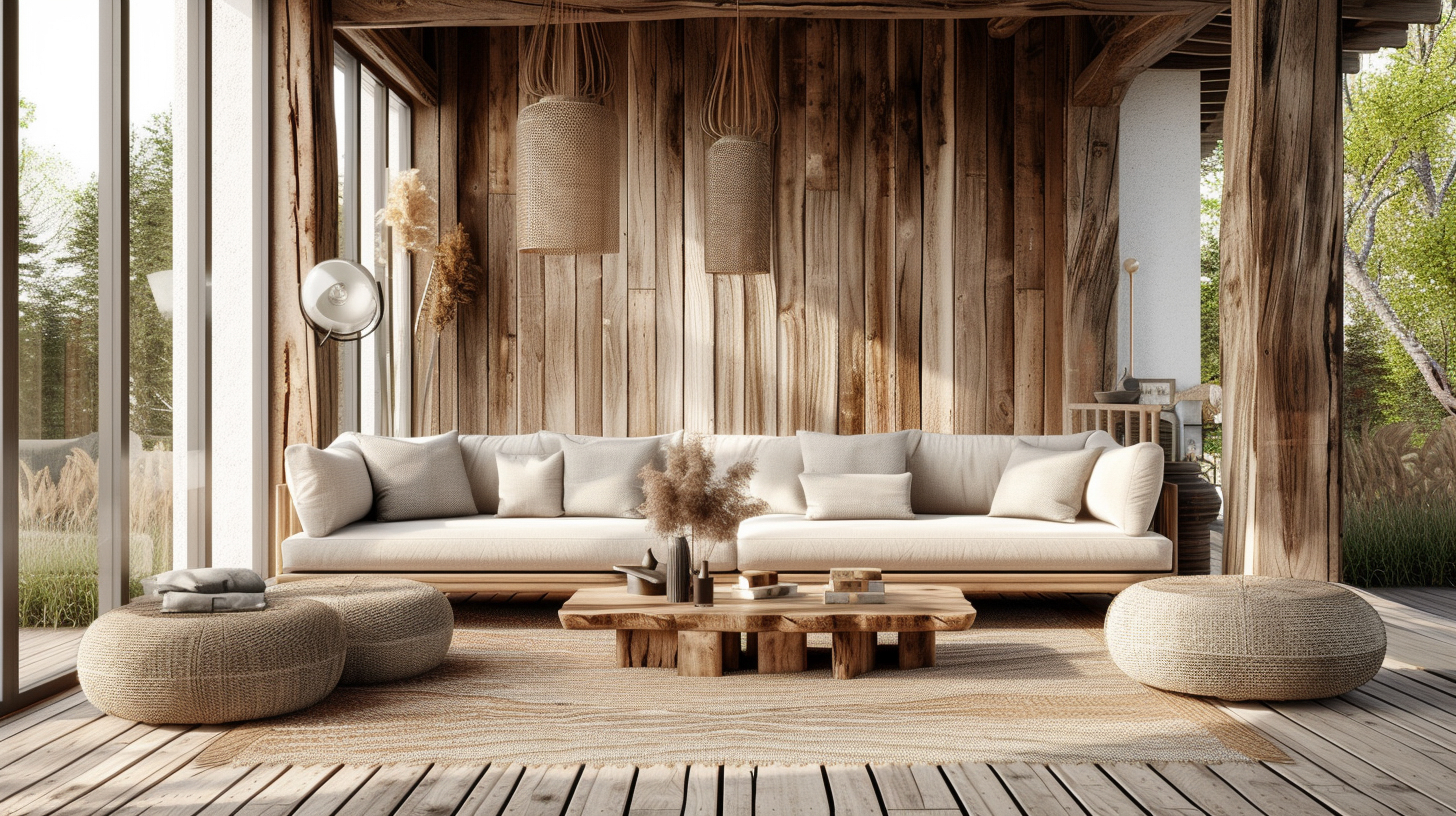
One of the defining features of interior design in 2025 is the breaking of stylistic boundaries. Designers and homeowners alike are embracing hybrid identities that reflect individual taste without being bound by rigid rules. Among the most successful of these pairings is the Modern + Farmhouse blend a meeting point between sleek minimalism and cozy authenticity.
In this style, you might find a kitchen with glossy white cabinetry and streamlined finishes, anchored by a rustic wooden island or accented with vintage-inspired metal stools. Or perhaps a living room featuring a contemporary neutral-toned sofa, sitting alongside a handcrafted reclaimed wood coffee table and a traditional-patterned rug. It’s a graceful fusion of technology and tradition, polish and warmth, that brings out the best of both worlds.
The magic of this blend lies in its flexibility. You can introduce simple farmhouse touches like lantern-style lighting, linen drapery, or barn-style sliding doors into a modern architectural shell without visual clash. On the contrary, the juxtaposition creates richness and a sense of lived-in character.
This movement also echoes a deep emotional need we’re seeing in today’s fast-paced world: a desire for spaces that feel current and calming, refined yet rooted. It has inspired concepts like “quiet retreat” design, which balances smart innovation with nostalgic comfort.
Whether you’re drawn to open-plan layouts and clean palettes, or you love rustic textures and earthy tones, the Modern + Farmhouse style offers a timeless aesthetic. It adapts to evolving tastes while always delivering the perfect harmony of heritage and innovation a design approach built to last.
Wellness Zones at Home: Spaces for Calm and Contemplation
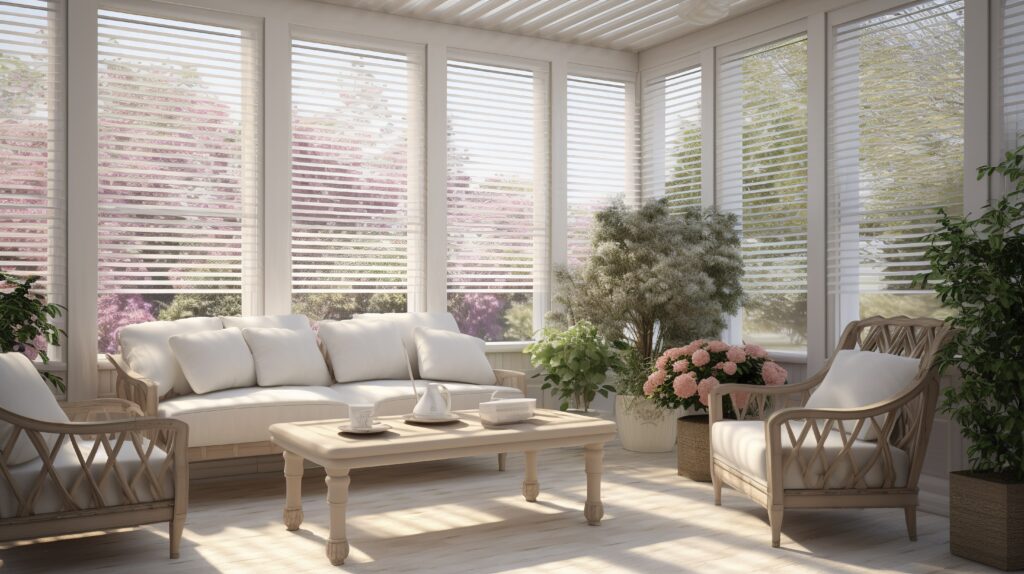
In an increasingly hectic and overstimulating world, the home is being reimagined as more than just a place of visual comfort it’s becoming a sanctuary for mental and physical well-being. That’s why “Wellness Zones” are emerging as one of the leading interior design trends for 2025. These are small but impactful spaces intentionally designed to provide rest, reflection, and mental recharge.
The beauty of wellness zones is that they don’t require a large footprint or full separation from the rest of the house. Sometimes, it’s simply a peaceful corner by a window with a soft rug, a meditation cushion, and ambient lighting. In other cases, it’s a fully curated area with natural wood flooring, a raw stone wall, and a yoga mat positioned to catch the morning light.
What sets this trend apart is its intuitive design approach. It’s less about aesthetic and more about creating emotional resonance. Color palettes often lean into tranquil shades like Misty Blue or Peach Fuzz, while materials include breathable cottons, soft linens, and warm-toned woods. Lighting plays a vital role too natural daylight or soft directional lamps enhance the room’s energy and atmosphere.
In some homes, wellness areas expand into sunrooms or conservatories with expansive windows, transforming them into light-filled sanctuaries. Here, the experience is elevated with scented candles, diffusers, and gentle ambient music, turning everyday moments into acts of restoration.
Whether you’re working from home or navigating a fast-paced lifestyle, creating a wellness corner no matter how modest can reshape your relationship with your space. It becomes a personal retreat where relaxation, reflection, and healing are always within reach.
Conclusion: Your Home Reflects You… and Zory Guides the Way
Interior design trends in 2025 go far beyond furniture and color they embrace a conscious lifestyle built on harmony, comfort, and self-expression. From blending styles and embracing texture and light to creating personal wellness corners, every corner of the home now carries meaning, personality, and purpose.
But turning these beautiful ideas into reality can feel overwhelming or seem like it requires a professional touch. That’s where Zory comes in a smart platform that offers more than just inspiration. It empowers you to design your space confidently and effortlessly.
Whether you’re starting a full furnishing project or simply refreshing a wall or corner, Zory supports your vision with a rich library of curated products, 3D visualization tools, and personalized suggestions based on your taste, space, and lifestyle.
At Zory, design doesn’t start from scratch it starts from you: your style, your rhythm, and the details that bring you joy.
The result? A home that doesn’t just look beautiful… it feels like you, crafted with intention and your signature.
